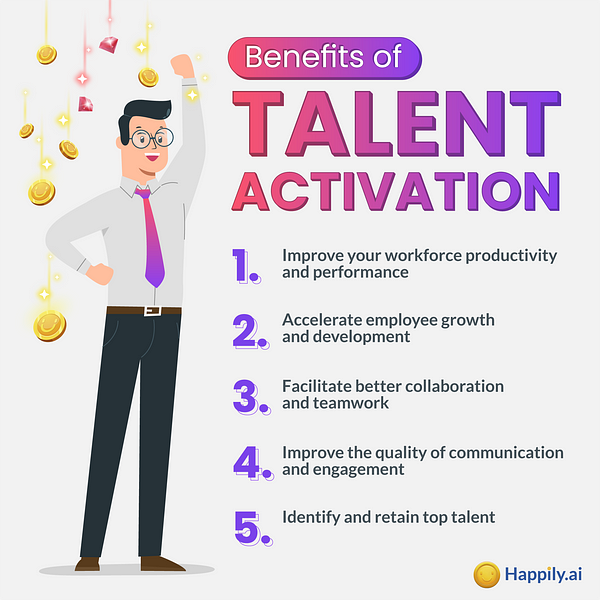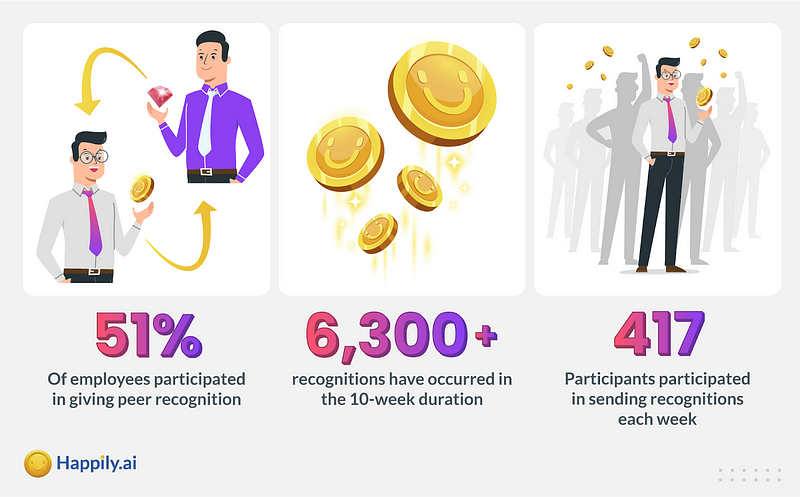Creating a culture of feedback and recognition is hard. Happily makes it easy — more than half of employees regularly give and receive feedback and recognition on the platform.
Introduction
“Acquiring the right talent is the most important key to growth.” — Marc Bennioff, Founder, chairman, and co-CEO of Salesforce
The most important thing a company leader does is hire talent. This is especially true when building and growing a business, as progress is propelled not by existing technology or know-how but by people. Strategy and process are often an early distraction. The reality is that people drive business outcomes.
But not all our people are primed and provided with the opportunity to contribute their consistent best. And that’s the value of great people leaders; they understand how to activate their talent.
What is talent activation?
Talent activation is the process of engaging your people in a way that drives productivity; by realizing the potential of each person.
Leaders, people managers, and human resource teams drive talent activation. Each plays a vital part in creating an environment and providing tools that allow for proactivity and initiative, focusing on feedback. With continuous feedback in place, organizations thrive on better communication, a climate of trust and openness, and cooperation within and between teams. Managers are more confident and able to lead and guide progress.
Managers are talent activation leaders
What do great managers do to get the best out of their people? They take the time and effort to understand, guide, and develop people. They are willing to sacrifice their personal growth for the success of others. And they are central to activating talent by enabling timely and honest feedback.
Exceptional company leadership is not enough. People managers who do not engage in feedback are limiting the potential of others.
Benefits of Talent Activation
- Improve your workforce productivity and performance. Employees who engage in regular feedback have a better understanding of their strengths and weaknesses and are more adaptable and focused on goals.
- Accelerate employee growth and development. Regular check-ins allow managers to provide timely guidance on personal growth goals and career development opportunities.
- Facilitate better collaboration and teamwork. Employees who participate in peer feedback have a better understanding of how others perceive them and how they contribute to those around them. Inspiring conversations around work/personality styles help people understand how they can work with others effectively.
- Improve the quality of communication and engagement. Trust and resilience are developed through strong bonds and relationships at work. Community-driven activities and meaningful conversations are the catalysts for these relationships to form.
- Identify and retain top talent. According to research, top performers are most motivated by doing work that others will appreciate. By facilitating recognition between employees and managers, we motivate top performers and have increased visibility on who has the most significant impact on others. And with real-time feedback, we can proactively solve for expectation gaps and better retain talent.

Study & Results
Our study’s objective is to learn about Happily’s potential to activate talent — to see if the right platform is in place, would employees regularly participate in upwards feedback and peer recognition?
We studied 1,959 employees across five companies throughout 10-weeks (some companies had been using Happily for three years, and some for less than a year). Our regular feedback measurement is to see how many weeks (of the 10) an employee participated in sharing feedback. The activity of peer-to-peer recognition is measured similarly.

The results show that more than half of the employees participated in sharing feedback every single week (10 weeks continuously) in four companies, and less than half in one company. Employees who are most active in sharing feedback (ten weeks continuously) make up 52% - 70% of all employees in most companies. Even in the lowest consecutive feedback case, almost 1 in 3 employees (30%) participated in feedback every week.
More than half of this group of employees participated (992 out of 1959 users or 51%) in giving peer recognition. Recognition was sent over 6,300 times in the 10-week time duration. On average, 417 participants participated each week, and recognition was provided 153 times every week per 100 participants.

Four ways to activate your employees’ talent
Talent activation is a vital part of the talent management process. It is a series of activities that help you to realize the full potential of your employees. In doing so, a strong connection is created between your organization and employees, leading to better performance and resilience. Here are four key ways to activate talent:
- Encourage your employees to give feedback. Giving your employees a voice attributes them with ownership, accountability in their work. Foster a culture where employees feel comfortable expressing their thoughts and understand the value of critical feedback.
- Use technology and provide tools and resources to increase productivity. Employees can become quickly disengaged when working with the wrong tools or are hindered by slow progress or unnecessarily complex workflows.
- Set up regular one-on-one meetings. Creating meaningful discussion opportunities each week allows managers to contribute in a tactical way, clear critical blockers, and strengthen relationships within teams.
- Empower your employees with peer recognition. Giving employees a chance to provide recognition to others is an extension of trust. And when employees feel that their contributions and values are appreciated, they are more likely to go the extra mile.

Conclusion
People are the most important asset in any organization. Highly skilled and motivated employees are your biggest drivers of success. However, not all employees are engaged and motivated — they need to be activated first. Activate your talent by giving them the opportunity to share feedback and give recognition, and they will do it regularly.
Happily is a one-of-a-kind platform that drives unprecedented feedback, recognition, insights, coaching, and more. Visit our website to learn more, request a demo, and be on your way to activating your talent.

References:
[1] https://blog.matrixlms.com/talent-activation-and-what-you-should-be-doing-about-it/
[2] https://searchhrsoftware.techtarget.com/definition/talent-activation









